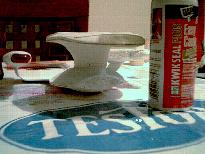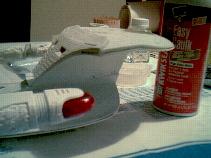|
 Caulk! I've discovered Caulk is a phenomenal mask!
Caulk! I've discovered Caulk is a phenomenal mask!
I was messing around with the different methods of
masking over the last couple of days - tape was really great and effective,
except that masking intricate or oddly curved areas (like a deflector dish..
Ouch!) was downright painful. I'll be masking about 100 windows the
thickness of the white of my pinkienail - I needed something much easier.
Not to mention the fact that your control of the knife has to be perfect when
you trim, or else you scratch what would have been your perfectly clear glass.
I tried Contact Rubber Cement - bad idea. Melted
the plastic.
As I looked for other items I could use I found
silicone caulk, standard tube caulk, and this stuff. It's water soluble,
and much like Elmer's glue makes little beads when you rub your fingers
together. It doesn't attack the plastic, nor paint (though that hasn't
been confirmed on multiple paint types at this point, I'm learning about it as I
go along). Here's how I used it:
 Have
toothpicks handy, and paper towels / napkins Have
toothpicks handy, and paper towels / napkins- Squirt a bit of the caulk in the center of the thing you want to
cover.
- Use a toothpick to spread it all over (or put the caulk on the
toothpick first for tiny spaces) - it's easier to remove if it's
moderately thick (but not overly so). Don't worry about going
outside the area you intend to cover yet.
- Start shaping the edges of the caulk that have begun to dry - if
you're covering a moderate area (say, the blue plastic on the side of a
warp nacelle) by the time you're done with one end, the other will have
started to dry. This is best done by first using your finger and
just pushing it over itself off the edge you don't want to mask.
Then use your toothpick to sort of "pat down" the folded over
material to make a perfect edge.
- Once this is done, use your finger to gently pat down any blobs or
surface irregularities - don't want anything sticking up in the stream of
the paint.
- After all is said and done, you can begin removal of the caulk
mask. By this time it's become reasonably tough stuff, not nearly as
malleable. Scraping it off with your fingernail works well, then the
tip of the toothpick. Once it's all cleaned off, you can polish with
a damp Q-Tip. I tried using dental tools, which works for tough
spaces but be careful not to scratch your masked surface
with them.
I'm thrilled with the results. Each item masked still
requires a great deal of care and attention to even the slightest detail, but I
think it's easier to work with than masking tape in tight spaces.
As a side note - filling in cracks by fusing plastic with
the plastic melting adhesive then filing / sanding works best, then putty -
filling in with cement doesn't work.
|
|

